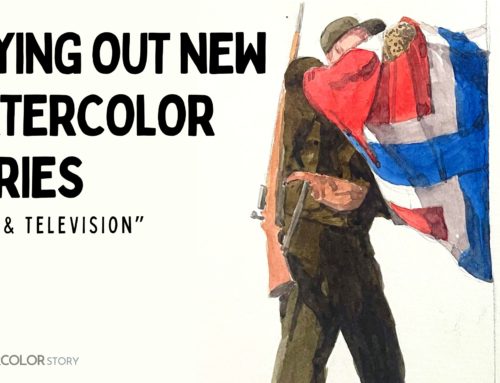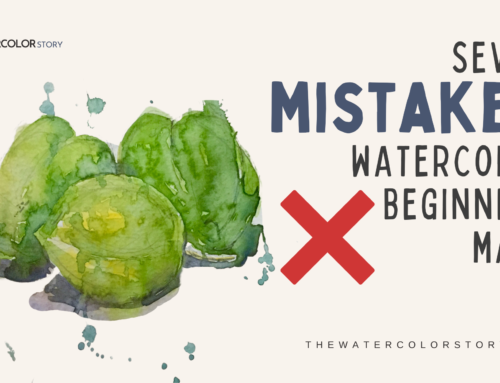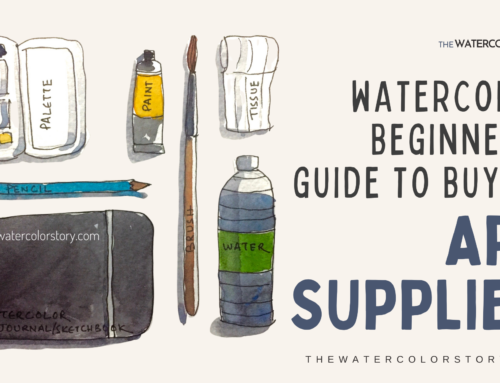
Do you remember the first time you picked up a paintbrush and marveled at the colorful magic it could create on paper? The excitement and passion that comes with discovering the world of watercolors is unparalleled. As a beginner or aspiring watercolor artist, you may find yourself yearning to improve your skills and explore new techniques. One essential aspect of your artistic journey is selecting the right watercolor brushes. The perfect brush can elevate your work, while the wrong one can lead to frustration and disappointment.
In this comprehensive guide, we will explore the wonderful world of watercolor brushes, discussing everything from different types and materials to their proper care and maintenance. Our goal is to help you, the beginner or aspiring artist, make informed decisions that will enhance your painting experience and unleash your true artistic potential. So, grab a cup of your favorite beverage, and let’s embark on this exciting journey together.

Types of Watercolor Brushes
Types of Watercolor Brushes: Finding Your Perfect Match with Watercolor Brushes
Understanding the various types of watercolor brushes is essential for choosing the right tools for your projects. Here, we’ll delve into the main types of brushes you’ll encounter and the purposes they serve:
Round Watercolor Brushes
Round brushes are versatile and popular among artists of all skill levels. They have a rounded, pointed tip, allowing them to create fine lines, fill in small areas, and add intricate details. As a beginner, you’ll likely find yourself reaching for round brushes often, as they are excellent for various techniques and effects.
Subtypes of Round Watercolor Brushes
- Standard Round: This is the most common round brush, with a fine point and a balanced belly, which holds the paint.
- Detail Round: With a shorter, more pointed tip, these brushes are ideal for extremely detailed work.
- Rigger: These brushes have long, thin bristles, perfect for creating long, flowing lines and intricate details, like rigging on ships.
Flat Watercolor Brushes
Flat brushes have a straight edge, making them ideal for creating bold strokes, filling in large areas, and producing sharp edges. They can hold a significant amount of water and paint, allowing you to cover more surface area with each stroke. Flat brushes are excellent for creating washes and applying large blocks of color.
Subtypes of Flat Watercolor Brushes
- Standard Flat: These brushes have a squared-off edge, perfect for general use.
- Bright: With shorter bristles and a more squared edge, bright brushes allow for better control and are ideal for thick, textured applications.
- Angle: These brushes have a slanted edge, offering more precision and control for creating angular shapes and lines.
Filbert Watercolor Brushes
Filbert brushes have a rounded edge, making them great for blending and creating soft edges. They are versatile and can be used for various techniques, such as creating rounded shapes, filling in large areas, and blending colors.
Fan Watercolor Brushes
These brushes have a unique, fan-like shape and are used to create textural effects, such as grass, foliage, or clouds. While not as commonly used by beginners, fan brushes can add interesting textures and depth to your paintings as you advance in your skills.
Detail Watercolor Brushes
As the name suggests, detail brushes have small, pointed tips, making them perfect for intricate work and fine details. These brushes are ideal for adding finishing touches, such as highlights or delicate patterns.
Materials Matter: Natural vs. Synthetic Watercolor Brushes
Watercolor brushes can be made from natural hair or synthetic fibers. Each type has its advantages and disadvantages, so it’s essential to understand their properties to choose the brushes that best meet your needs.
Natural Hair Watercolor Brushes
Natural hair brushes are often made from animal hair, such as sable, squirrel, or hog. These brushes are prized for their ability to hold more water and paint, providing smoother paint application and better color retention. However, they tend to be more expensive and may require extra care to maintain their quality.
Types of Natural Hair Watercolor Brushes
- Kolinsky Sable: Considered the finest natural hair brush, Kolinsky sable brushes are known for their exceptional quality, softness, and ability to hold water and paint. They are also quite expensive, making them an investment for serious artists.
- Red Sable: While not as luxurious as Kolinsky sable, red sable brushes still offer excellent performance and durability at a more affordable price point.
- Squirrel: Squirrel hair brushes are soft and absorbent, making them great for washes and large areas of color. They tend to be more affordable than sable brushes.
- Hog: Stiff and durable, hog hair brushes are suitable for rougher techniques and lifting paint. They are the most affordable natural hair brushes.
Synthetic Watercolor Brushes
Made from materials like nylon or polyester, synthetic brushes are more affordable and easier to maintain. They are also more resilient and can hold their shape well, but they might not retain water and paint as well as natural brushes.
Types of Synthetic Watercolor Brushes
- Golden Taklon: Known for its high-quality performance and durability, golden taklon brushes are soft and smooth, making them an excellent choice for watercolor artists.
- White Taklon: A more affordable option, white taklon brushes are still durable and suitable for watercolor painting, although they may not perform as well as golden taklon brushes.
- Blended: Some brushes are made with a blend of natural and synthetic fibers, offering a balance between the benefits of both materials.
Key Factors to Consider When Choosing Watercolor Brushes
When selecting the perfect watercolor brushes for your collection, keep these factors in mind:
Shape and Size
Choose brushes that suit your painting style and the size of your artwork. A diverse range of brush shapes and sizes is essential for versatile painting. Experiment with different brushes to find the ones that work best for you and the techniques you enjoy.
Bristle Material
Consider the pros and cons of natural and synthetic brushes, and select the material that best meets your needs and budget. Keep in mind that some artists prefer a mix of both types, utilizing the strengths of each material for different techniques.
Quality
Investing in high-quality brushes is a smart decision, as they will provide better performance and longevity. While you may be tempted to save money on cheaper brushes, remember that high-quality brushes will ultimately save you money and frustration in the long run.
Handle Length
Choose handles that are comfortable to hold and provide good control. Handles come in various lengths, such as short, standard, or long. Experiment with different handle lengths to determine which is most comfortable for your painting style.
Proper Care and Maintenance of Your Watercolor Brushes
To prolong the life of your brushes and ensure consistent results, follow these care and maintenance tips:
Cleaning Your Watercolor Brushes
- Rinse your brushes thoroughly after each use, removing any excess paint.
- Use a gentle soap, like a brush cleaner or mild dish soap, to clean your brushes, and rinse them well.
- Gently squeeze the bristles with a clean towel or paper towel to remove excess water.
- Reshape the brush head before allowing it to air-dry.
Storage and Protection
- Store your brushes horizontally or with the bristles facing upward to maintain their shape.
- When transporting brushes, use a brush case or protective cover to prevent damage to the bristles.
- Avoid leaving your brushes soaking in water for extended periods, as this can cause the bristles to become misshapen and the handle to crack or warp.
Regular Maintenance
- Inspect your brushes regularly for signs of wear or damage. Replace brushes that have become frayed, misshapen, or otherwise unusable.
- Avoid using your watercolor brushes with other types of paint, such as oil or acrylic, as this can damage the bristles and affect their performance with watercolors.
Top Watercolor Brush Brands to Consider
As a beginner or aspiring artist, you may be overwhelmed by the number of watercolor brush brands available on the market. To help you make an informed decision, here are some top brands to consider:
- Winsor & Newton: Known for their high-quality art materials, Winsor & Newton offers a range of watercolor brushes, including the renowned Series 7 Kolinsky Sable brushes.
- Da Vinci: This German brand is well-regarded for its excellent craftsmanship and offers a variety of both natural and synthetic brushes.
- Escoda: A Spanish brand with a reputation for producing high-quality brushes, Escoda offers a range of natural and synthetic options to suit all budgets.
- Princeton: Princeton is a popular choice for affordable, high-quality synthetic brushes, such as their Neptune and Velvetouch lines.
- Raphael: A French brand known for its exceptional craftsmanship, Raphael offers high-quality natural hair brushes, including the renowned 8404 Kolinsky Sable line.
- Rosemary & Co: Handmade in England, Rosemary & Co brushes are praised by professional artists for their quality and performance. They offer a variety of natural and synthetic brushes to suit different preferences and budgets.
- Silver Brush Limited: This brand offers a wide range of brushes, including the popular Black Velvet line, which features a blend of natural squirrel hair and synthetic fibers, providing an excellent balance between performance and affordability.
- Royal & Langnickel: Offering a range of affordable brushes for artists of all levels, Royal & Langnickel is known for its quality synthetic brushes, including the Soft-Grip and Zen lines.
- Daler-Rowney: With a long-standing reputation for producing high-quality art materials, Daler-Rowney offers a selection of watercolor brushes, such as the Dalon and Diana lines, that cater to both beginners and advanced artists.
Putting It All Together: Building Your Watercolor Brush Collection
As a beginner or aspiring artist, building a well-rounded watercolor brush collection is essential for exploring different techniques and styles. Start with a selection of round, flat, and filbert brushes in various sizes, as well as a few detail brushes for intricate work. As you advance in your skills and discover your preferred techniques, consider adding specialty brushes, like fan brushes, to your collection.
Remember that investing in high-quality brushes will not only improve your painting experience but also save you money in the long run. Take the time to research and experiment with different brands and materials to find the brushes that best suit your needs and style.
Conclusion
Choosing the right watercolor brushes is a crucial step in mastering your art. By understanding the different types of brushes, materials, and key factors to consider, you can make informed decisions that will enhance your painting experience. Remember to care for your brushes properly, and they will reward you with beautiful, lasting artwork. Now it’s time to pick up your brushes, unleash your creativity, and let your passion for watercolors flourish.





Leave A Comment